Japan introduced new banknotes on July 3, 2024, marking the first design update in roughly 20 years. The updated notes incorporate advanced anti-counterfeiting technology and feature a universal design, including larger Arabic numerals for better accessibility. Electronic money is indeed becoming more prevalent, but cash is still widely used in Japan. While new and old banknotes circulate together, some people may need clarification on the design change. To avoid confusion, it will be helpful to familiarize yourself with the new and old designs. For example, why not learn a little about the people whose portraits are on the banknotes?

Whose portraits are on the new Japanese banknotes?
The new banknotes introduced in 2024 have a portrait of pioneers who played a major role in the modernization of Japan, leading Japan to become a modern nation that remains a cornerstone of the country to this day.
New 10,000 yen note – SHIBUSAWA Eiichi
SHIBUSAWA Eiichi 渋沢栄一(1840 – 1931)
Shibusawa Eiichi was a tycoon who was involved in the establishment of 500 companies during his lifetime. Shibusawa is known as “the creator of modern Japanese society” and “the father of Japanese capitalism.”
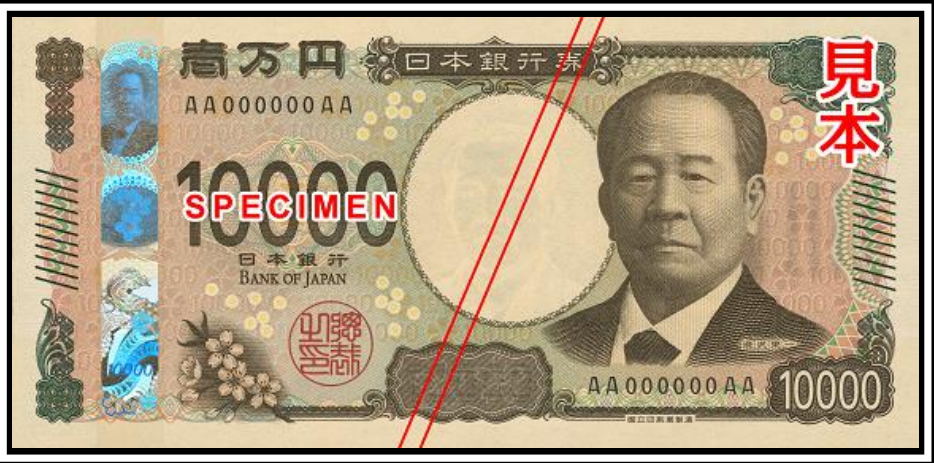
New 10,000 yen note. Image © Bank of Japan www.boj.or.jp
Shibusawa was born into a wealthy farming family around the end of the Edo period, the samurai era. While assisting with the family business, he received academic education from his father and learned the Analects of Confucius from his cousin. Through the education and skills that he acquired, Shibusawa became a samurai serving the Shogun family. At the age of 27, Shibusawa had an opportunity to travel to Paris for the World Exposition and various European countries. During his travels, he gained insights into the structure of modern social systems while encountering advanced technology and industries. After the samurai era ended and Japan established its new government, he joined the Ministry of Finance as a bureaucrat and contributed significantly to the nation’s reconstruction. After retiring from government service, Shibusawa contributed to Japan’s modernization through the economy by founding companies and organizations such as banks, railway companies, and electric power companies that are still prominent today. He was involved in establishing 500 companies in his lifetime and supported nearly 600 educational institutions, medical institutions, and research institutions.
New 5,000 yen note: TSUDA Umeko
TSUDA Umeko 津田梅子 (1864 – 1929)
Tsuda Umeko was one of the first Japanese women to study abroad. She was an educator who founded her own university and devoted herself to improving the status of women and educating women.
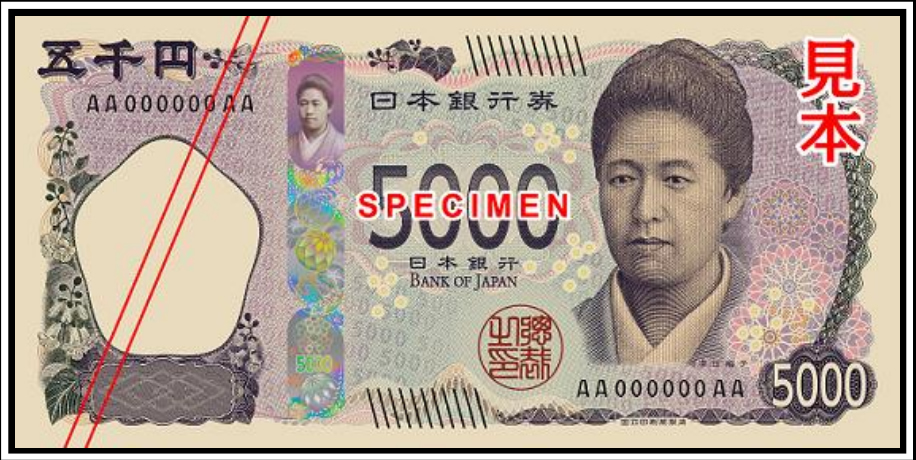
New 5,000 yen note. Image © Bank of Japan www.boj.or.jp
At the age of six, Tsuda Umeko went to the USA as one of Japan’s first female students to study abroad. She stayed with a host couple near Washington, DC, for about 11 years, where she absorbed the American way of living. After her return to Japan at 17, Tsuda was shocked to discover the situation of Japanese women. Motivated by a strong desire to improve the status of women, she returned to the USA to study at a university. There, she received a high-quality education in small classes, which helped her establish her own views on education. Returning to Japan, Tsuda taught as a professor at a girls’ school, then later founded a women’s institute for English studies, Tsuda University today.
New 1,000 yen note: KITASATO Shibasaburo
KITASATO Shibasaburo 北里柴三郎(1853 – 1931)
Kitasato Shibasaburo is known as the “father of modern Japanese medicine” as he was the first bacteriologist in the world to successfully cultivate the tetanus bacillus in pure culture.

New 1,000 yen note. Image © Bank of Japan www.boj.or.jp
Kitasato Shibasaburo started his career in medicine at 18 as he received support from a Dutch military doctor. While studying at a medical school in Tokyo, he decided to dedicate his life to preventive medicine. After working at the Ministry of Home Affairs’ Health Bureau, he went to Germany to study with Robert Koch, a leading researcher in pathogenic microbiology. In 1889, Kitasato became the first in the world to cultivate the tetanus bacillus successfully. He then discovered an immune antibody against the toxin and established serum therapy, which made him an internationally renowned researcher. After returning to Japan, he established the Institute for Infectious Diseases. He committed himself to the investigation of infectious disease prevention and bacteriology. In 1894, he identified the plague bacillus. Kitasato also made significant contributions to society, such as establishing the Faculty of Medicine at Keio University.
Whose faces are on the old Japanese banknotes?
The old series of Japan’s banknotes are valid as before after the new banknote released in 2024. Here is a brief summary of the faces that appear on the familiar banknotes.
Old 10,000 yen note: FUKUZAWA Yukichi
FUKUZAWA Yukichi 福沢諭吉 (1835年 – 1901年)
Fukuzawa Yukichi was an enlightened thinker who influenced the way Japanese thought during the transitional period from the end of the Edo period to the Meiji era. He is also the founder of Keio University.
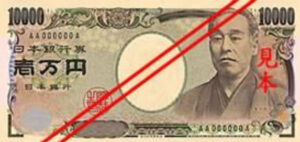
Old 10,000 yen note. Image © Bank of Japan www.boj.or.jp
Fukuzawa Yukichi was from a low-ranking samurai family. His father died when he was two years old, forcing him to grow up in poverty. Young Fukuzawa worked making geta sandals to support his family until he became interested in learning. He attended a private school at age 14 and studied Rangaku (study of Western knowledge) at 19. Despite financial difficulties, Fukuzawa persisted in studying at private schools and eventually established his own school, which later developed into Keio University in Tokyo. At the age of 25, Fukuzawa went to the USA as an envoy, where he was moved to see a society that allows people to succeed based on their abilities, regardless of their social status. This experience made him publish a book, “Gakumon No Susume (An Encouragement of Learning),” which argued that people are born equal and that differences in wealth and social status arise because of the presence or absence of education. This idea of the Enlightenment influenced Japanese people’s thoughts at that time.
Old 5,000 yen note: HIGUCHI Ichiyo
HIGUCHI Ichiyo樋口一葉 (1872年 – 1896年)
Higuchi Ichiyo was an independent woman who supported her poor family as a poet and novelist. In the 14 months before her death at the age of 24, she published a series of highly praised works that made her regarded as a leading female writer.
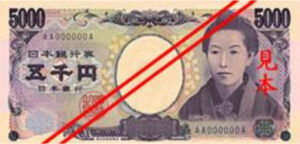
Old 5,000 yen note. Image © Bank of Japan www.boj.or.jp
Higuchi Ichiyo, born in Tokyo, was a daughter of a low-ranking official. Although she excelled in school in her early teens, her mother did not allow her to continue her education. Consequently, she chose to dedicate herself to studying waka poetry and novels. When her father died in 1889, the 17-year-old Higuchi was left to bear the family’s responsibilities and began to struggle to make ends meet. Despite working as a needleworker and running a candy shop, she was unable to escape poverty, and she decided to support her family by writing novels. Struggling with such financial hardships, Higuchi produced acclaimed works “Takekurabe,” “Nigorie,” and “The Thirteenth Night” in a short period of time and died of pulmonary tuberculosis at the age of 24.
Old 1,000 yen note: NOGUCHI Hideyo
NOGUCHI Hideyo 野口英世 (1876年 – 1928年)
Hideyo Noguchi, a physician and bacteriologist, engaged in research on infectious diseases not only in Japan but also in prominent research institutes overseas. He made significant contributions to the field and worked in countries heavily affected by epidemics, where he continued his research until he succumbed to an infectious disease himself.
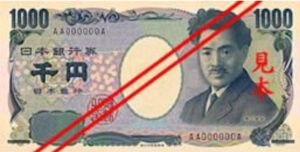
Old 1,000 yen note. Image © Bank of Japan www.boj.or.jp
Noguchi Hideyo was born into a poor farming family in the Tohoku region (Fukushima Prefecture). He suffered burns in his childhood that left him with a crippled left hand, and he sought a career in academia instead of being a farmer to make a living. While studying diligently, he met a mentor who assisted him in getting surgery to improve the movement of his fingers, which inspired him to pursue a career in medicine. After graduating from medical school in Tokyo, he went to the United States to work as a researcher at the Rockefeller Institute for Medical Research. He worked on a wide range of research, particularly successful in discovering spirochetes, the pathogen of syphilis, and establishing a method for culturing the pathogen. While making many achievements, he was infected with yellow fever during a visit to Africa. In the middle of researching the disease, Noguchi died in 1928 at the age of 51, and his life of passion and dedication to science came to an end.
Reference
National Printing Bureau: Introducing the three people whose portraits appear on the new banknotes
https://www.npb.go.jp/en/n_banknote/shokai/
Bank of Japa: A New Series of Banknotes and a New 500 Yen Coin
https://www.boj.or.jp/en/note_tfjgs/note/n_note/


